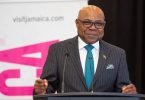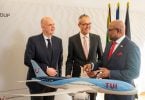2015 was a challenging year for Fastjet, in which the company encountered difficult macroeconomic conditions in its markets, continued delays in obtaining flying rights into Kenya even though some progress is now being made in that market, and new international routes not immediately meeting expectations. Add to that the shenanigans of a shareholder, the notoriously cantankerous Stelios Haji-Ioannou, who tried to stage a boardroom coup which prompted changes to executive management and the board. These challenges contributed to the less than favorable financial results and poorer than expected cash flow, which were set out in the Annual Report and Accounts 2015.
However, 2015 was also a year of network and fleet growth for Fastjet, having raised US$75 million by way of equity fundraising. The fleet grew from 3 to 6 aircraft, including the acquisition of the airline’s first owned aircraft. A second airline and base were launched in Zimbabwe in 2015, and the 2 operating units, Tanzania included, currently operate 13 routes to 11 destinations in 6 countries in Africa.
Since the launch of Fastjet Tanzania in 2012, the airline has carried over 2 million passengers. In 2015, over 775,000 passengers were carried, a 30 percent increase on the previous year.
In December 2015, Fastjet announced it had finally been granted approval by the Kenyan government to operate flights between Kenya and Tanzania. Flights between Dar es Salaam and Nairobi were launched in January 2016. However, the market proved more challenging than anticipated as Fastjet’s main competitor on the route was swift to counter the low fares with special offers of its own.
The business environment in which the company operates remains challenging. Although the yield per passenger continues to improve from its low point in October 2015, passenger numbers remain lower than projected even though domestic routes within Tanzania are showing signs of recovery once again, following the low point after the country’s general election. International services, however, according to regular sources, remain challenging.
Passenger numbers for the half year that ended June 30, 2016 were approximately 390,000 (2015: 363,726), but load factors have declined to 47 percent (2015: 70 percent) due to the increase in available capacity from the enlarged fleet over the past 12 months. Although the ongoing cost reduction program and the recent reduction in routes and fleet size are yielding material benefits, the company continues to be cash flow negative and, therefore, expects to report a trading loss for 2016.
Following a review of the company’s financial performance in 2015 and scrutiny of its operations, the board revised the business plan which includes input from the new CEO, Nico Bezuidenhout, and initially prioritizes various initiatives required to stabilize business in the short term.
These include continuing with the cost reduction program and ensuring careful management of the company’s current cash resources; rationalizing routes to match capacity with demand; and paring back expansion, with no new routes expected to launch for the remainder of 2016. A more flexible approach to the traditional low-cost carrier model will also be employed. Part of the new approach is a better alignment of the company’s infrastructure and fleet to its present stage of development. It is understood that the overheads for an airline of the size of Fastjet operations need to be reviewed to achieving the desired improvement in cost management.
There are a number of revenue-generating initiatives currently underway according to regular sources close to the airline. In June 2016, the company introduced a new mobile payment platform which offers a faster and more convenient means of payment for customers as well as lower transaction costs for Fastjet compared with the previous platform. The new system provides improved tracking and data analysis and broadens the geographical scope of Fastjet’s mobile money facilities, expecting to reach Fastjet customers in more countries and with an estimated 30% reduction in transactions costs.
A new consolidated call center opened in South Africa in June 2016 offering multi-lingual services and covering Tanzania, Kenya, Uganda, Zambia, Zimbabwe, and South African markets. The call center is expected to improve sales conversions and improve the quality of service provided to customers located in those important African markets.
The planned introduction of a Global Distribution System (GDS) in September 2016 is expected to increase sales through improved accessibility to travel agents and compatibility with other airlines’ schedules and ticketing as well as facilitating new and existing interline agreements. The new GDS will offer travel agents greater visibility of Fastjet’s routes and schedules and agents will be able to access Fastjet seats at better prices compared with the current structure.
Strengthening the board and its composition is another priority for the group. As announced on June 9, Mr. Nico Bezuidenhout will be joining the company on August 1 as its new Chief Executive Officer. Mr. Bezuidenhout joins Fastjet from Mango Airlines, the low-cost carrier subsidiary of South African Airways, where he has been CEO since Mango commenced operations 10 years ago. During his tenure, Mr. Bezuidenhout grew the airline’s market share to 25 percent of the South African domestic air travel market and the fleet to 10 Boeing 737-800 aircraft. He also achieved the lowest unit cost within the South African aviation industry through high aircraft utilization and sustained good load factors.
The board believes that Mr. Bezuidenhout will bring strong commercial and strategic skills and a wealth of experience of operating a low-cost carrier in Africa. This experience, together with his detailed knowledge of the markets in which Fastjet operates, will be invaluable to the company as it seeks to stabilize the business and capture growth opportunities in the region.
Although he has yet to join the company, the board and Mr. Bezuidenhout have already identified a number of opportunities to stabilize the business and address many of the challenges the company faces. These include a fundamental review of the fleet, both the size and type of aircraft operated, the routes flown, revenue generation initiatives, and the relocation of the head office to Africa.
Mr. Bezuidenhout will be based in Africa at a location yet to be disclosed and will oversee the relocation of support functions and management closer to its operations and market. The company also intends to further strengthen the board with additional non-executive directors in due course.
Upon joining the company in August 2016, Mr. Bezuidenhout will initiate a full review of the business. It is envisaged that an existing cost-cutting program will be complete by Q4 2016 when the second phase will be initiated. Further to the review, the company expects further route rationalization in Q4 2016 when it expects to announce the decision on its fleet. The decision on the head office relocation and its implementation are also expected to commence in Q4 2016. With new revenue initiatives due to commence in Q4 2016, the company is targeting a cash-flow, break-even position by the end of 2017.
It remains the company’s medium- to long-term strategy to realize its vision of becoming a pan-African low-cost carrier.
Although the ongoing cost reduction program and the recent reduction in routes and fleet size are already yielding material benefits, the company continues to be cash-flow negative. Accordingly, the funds raised from this proposed capital increase will provide the company with essential working capital and importantly the resources to affect the necessary changes to operations and fleet, to reduce costs further, and pursue revenue generating initiatives. In addition, funds received from the Open Offer will allow the board additional flexibility as they execute their new business plan. When the funding is in place, the board will implement its revised business plan and expects to see future growth markets improve.






















